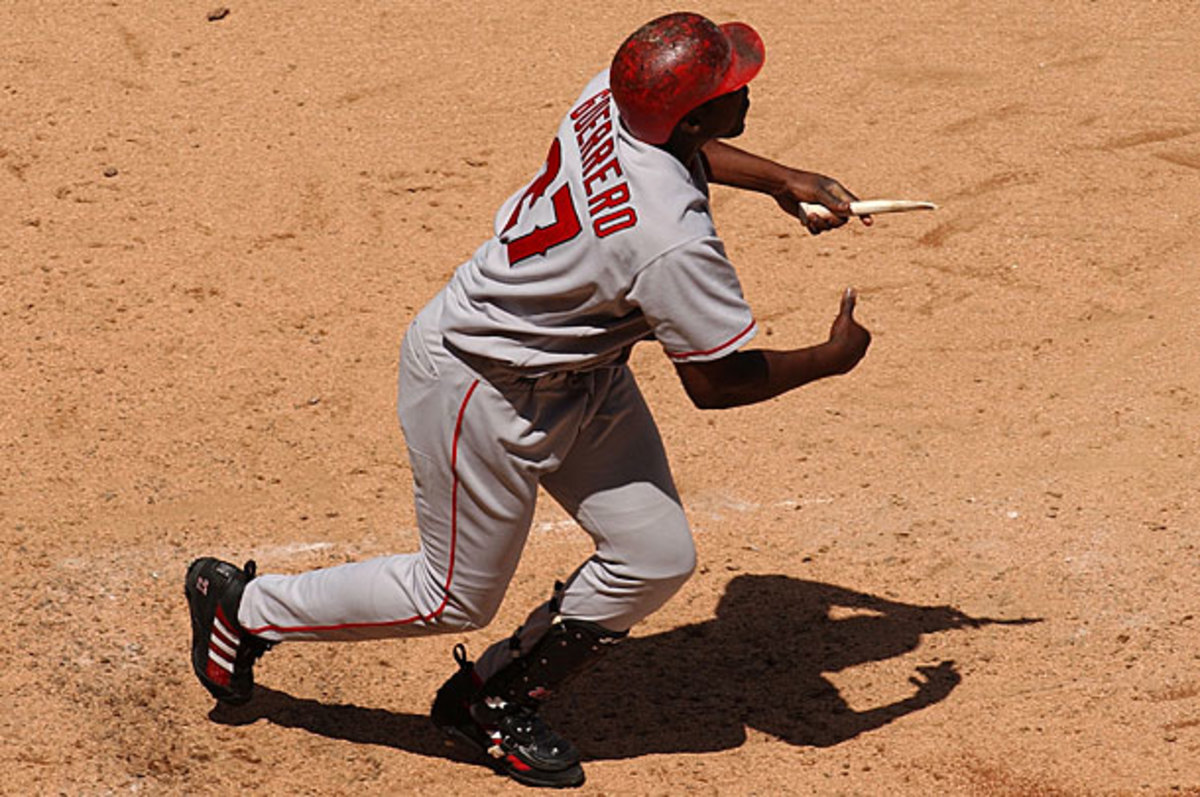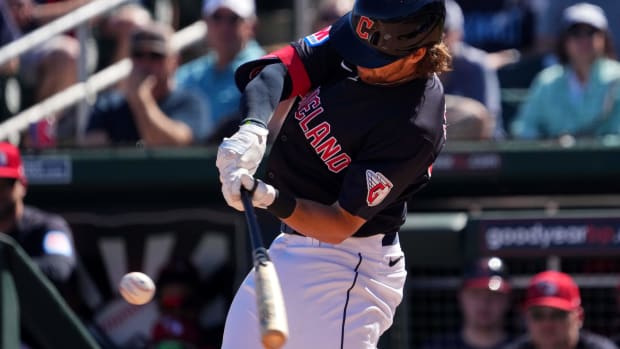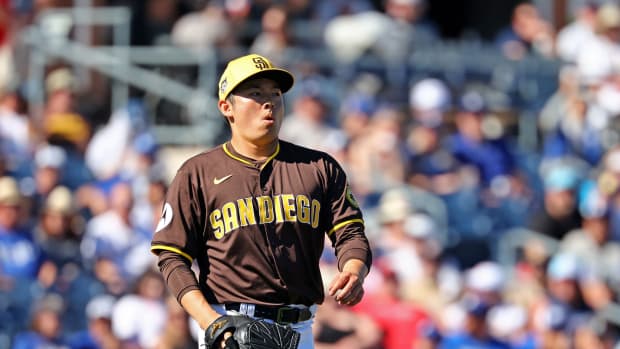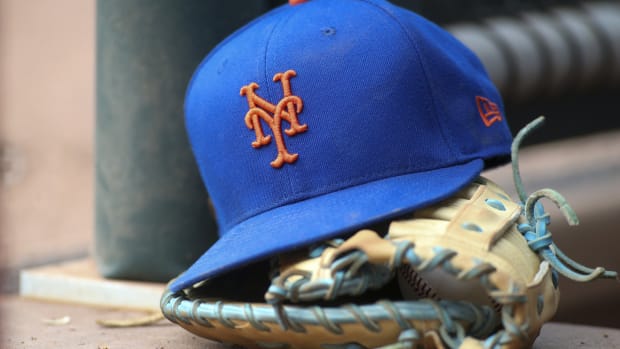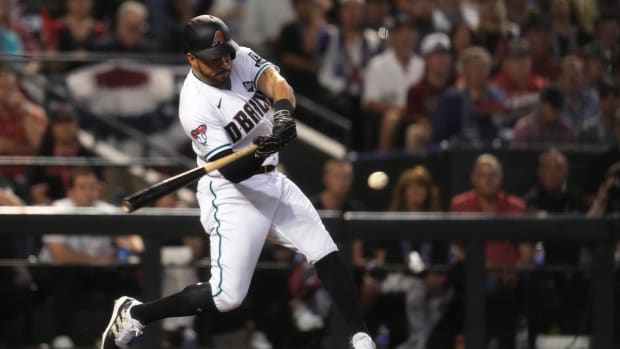Vladimir Guerrero announces his retirement and Hall of Fame should await
Vladimir Guerrero won the AL MVP award in 2004 and finished with more hits than any other Dominican-born player. (Jonathan Daniel/Getty Images)
Over the weekend, Vladimir Guerrero announced his retirement via the Dominican news outlet Listin Diario, formalizing his departure from the major league scene he has not been a part of since the 2011 season. The 38-year-old slugger made comeback attempts in each of the past two years, but the last of them ended this spring before it could get off the ground. While his numbers ensure strong consideration for Cooperstown, his legacy is as much about the fascinating rawness of his style. Long before Yasiel Puig burst on the scene, Guerrero clobbered pitches that most mortals wouldn't dream about swinging at, and displayed a cannon of an arm.
Guerrero grew up in such extreme poverty in the Dominican Republic -- no electricity, no running water -- that he drank from puddles as a child and shared two beds with six other family members. One of them was older brother Wilton, 16 months his senior, who was signed by the Dodgers in 1991. Vladimir was signed by the Montreal Expos an 18-year-old in 1993, and after debuting in September 1996 (see his first homer here), he was in the big leagues for good the following year, and even brought his mom with him to Montreal to cook for him. A broken foot and other injuries limited him to 90 games as a rookie, but his .302/.350/.483 line hinted at things to come.
Guerrero broke out in a big way in 1998, hitting .324/.371/.589 with 38 homers and 202 hits for a 97-loss team that didn't have a whole lot else to feel good about. He showed that was no fluke by belting 42 homers, hitting .316/.378/.600 and making the All-Star team for the first of nine times in 1999. For the five-year period from 1998-2002, he averaged 39 homers, 22 steals, 6.0 Wins Above Replacement and a .325/.391/.602 line; he reached the 30-30 club in 2001 (34 homers, 37 steals) and fell one homer short of the 40-40 club the following year. He gained renown as the game's best bad-ball hitter; he even homered on a pitch that bounced in the dirt. Here's what a scout told ESPN's Tim Kurkjian in 2002:
"He can cover the plate, he can cover the opposite batter's box and he can cover the pitch over his head," said one scout. And he can hit those pitches for home runs. He can take a slider down and away, and scorch it down the right-field line. A lot of players can hit the pitch that's two or three inches off the plate if they're looking in that location, but only guys such as Guerrero can hit that pitch when they're not looking there. "If I were a pitcher," the scout said, laughing, "I'd throw it down the middle to Tony [Gwynn] and Vladdy."
Despite his aggressive approach, Guerrero's power demanded the utmost respect, so he drew enough intentional walks (as many as 32 in a season) to push his on-base percentage above .400 in some years, with a high of .426 in 2003. While he never won a batting title, he finished third in the league four times and was above .300 for 12 straight years (1997-2008). His powerful arm was another story; he led his league's rightfielders in assists three times and finished in the top four nine times, but he also led in errors nine times, including seven years in a row from 1997-2003. Even so, the cost was relatively minimal in the context of his overall play, and when those throws were on the money...
[mlbvideo id="25718693" width="600" height="336" /]
Guerrero missed six weeks due to a lower back injury in 2003, his final year in Montreal. By then, the Expos were already wards of the other 29 teams and in their penultimate season before moving to Washington, D.C. His departure via free agency was a foregone conclusion, though he did put on a show before he left. Here he is hitting for the cycle on Sept. 14, 2003, three days before his final home game at Olympic Stadium:
[mlbvideo id="20064825" width="600" height="336" /]
Though he was heavily pursued by the Dodgers as a free agent to the point that they believed they had a deal — "It was done, everything but the signature," said chairman Bob Daly later — their unsettled ownership situation cost them. Instead, he signed a five-year, $70 million deal with the Angels.
It paid off quickly. Guerrero hit .337/.391/.598 with 206 hits and 39 homers for the Angels in 2004; his .363//.424/.726 showing with 11 homers in September helped the Halos overtake the A's in the AL West race and made enough of an impression on voters that he snatched the AL MVP award away from fellow rightfielder Gary Sheffield. He helped the Angels to five first place finishes in six years, batting .323/.387/.557 with an average of 32 homers a year for the first five of them (2004-2008) before injuries limited him to 100 games, 15 homers and a .295/.334/.460 line — all career lows — in 2009, his walk year. Transitioning into full-time DH duty, he signed a one-year deal with the Rangers, bopped 29 homers and helped them reach the 2010 World Series, but went just 1-for-14 in his lone Fall Classic.
After a less impressive season as a DH with the Orioles (.290/.317/.416 with 13 homer) in 2011, the going-on-37-year-old Guerrero was unable to find a major league deal to his liking. He finally signed with the Blue Jays (whose general manager, Alex Anthopoulos, was a former Expos intern) and after spending a couple of weeks in their extended spring training camp, played in 12 games at two stops, hitting .358/.364/.679 with four homers in 55 PA. Toronto couldn't find room on its roster soon enough for his liking, so he opted out of his contract in mid-June.
Guerrero couldn't find another deal, but even after struggling in a brief Dominican Winter League appearance, he remained determined to mount one more comeback effort. He put out a short video showing him training in the D.R. and expressed a desire to play long enough to add another 51 homers to his career total to reach 500, but the best he could do was a contract with the Long Island Ducks of the independent Atlantic League. Alas, due to family issues, he never actually joined the team, and now it appears he's reached the conclusion that he's done. "I decided to announce my retirement due to my desire to spend more time with my family," he told Listin Diario (in Spanish), "as well as because of the two operations that I've had on my right knee."
Despite not playing in the majors past his age-36 season, Guerrero finishes with a career .318/.379/.553 line, strong totals of 2,590 hits — a record for Dominican-born players, four more than Julio Franco — and 449 home runs, plus an MVP award and nine All-Star appearances. He'll be eligible on the 2017 Hall of Fame ballot, one that could find him joining two other generations of great, Cooperstown-worthy Expos outfielders in Tim Raines and Larry Walker. He may fare better among traditionalists than statheads; via my JAWS system, Guerrero doesn't have quite the airtight case you might expect due to his disappearance in his mid-30s.
While his 41.2 WAR for his seven-year peak is close enough to the average Hall of Fame rightfielder (42.0) to be a tossup, Guerrero finished with "only" 59.9 WAR for his career, 11 wins short of the positional average, and his 50.6 JAWS -- the average of peak and career scores -- is thus 5.8 wins short of the position's 56.4 average. That score ranks 20th among all rightfielders, just below Dave Winfield (64.0/37.7/50.9) and just ahead of Sheffield (60.4/38.0/49.2). Twelve enshrined rightfielders are above him, and while that still means 10 are below him, the only one among them elected by the Baseball Writers Association of America (as opposed to the Veterans Committee) was Wee Willie Keeler, and that was back in 1939.
Given a ballot logjam that among outfielders could include Raines (who would be in his 10th year of eligibility), Walker (seventh year), Barry Bonds and Sammy Sosa (both in their fifth year), Ken Griffey Jr. (if he doesn't make it in on the first ballot in 2016), Luis Gonzalez (fourth year), Jim Edmonds (second year), Sheffield and Manny Ramirez (both also debuting) and more, Guerrero's candidacy will have to battle for attention and space. Unlike many of the aforementioned, he has no known connection to performance-enhancing drugs, but like them, he put up his big numbers in an offense-happy era. As Raines and Walker have shown, the Expos' disappearance is no boon to a candidate. On the other hand, like previously elected Montreal predecessors Andre Dawson and Gary Carter, Guerrero played the second half of his career in a larger media market, which could make up for some of that.






























